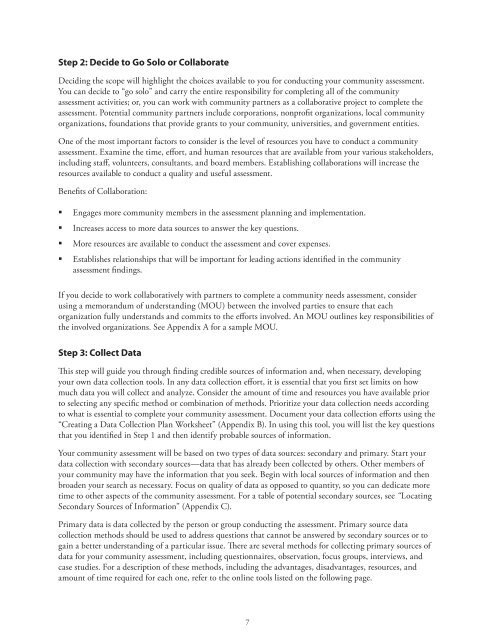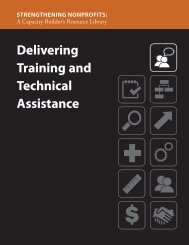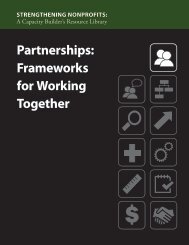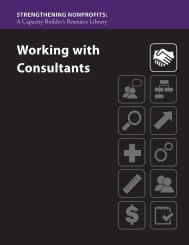Conducting a Community Assessment - Strengthening Nonprofits
Conducting a Community Assessment - Strengthening Nonprofits
Conducting a Community Assessment - Strengthening Nonprofits
You also want an ePaper? Increase the reach of your titles
YUMPU automatically turns print PDFs into web optimized ePapers that Google loves.
Step 2: Decide to Go Solo or CollaborateDeciding the scope will highlight the choices available to you for conducting your community assessment.You can decide to “go solo” and carry the entire responsibility for completing all of the communityassessment activities; or, you can work with community partners as a collaborative project to complete theassessment. Potential community partners include corporations, nonprofit organizations, local communityorganizations, foundations that provide grants to your community, universities, and government entities.One of the most important factors to consider is the level of resources you have to conduct a communityassessment. Examine the time, effort, and human resources that are available from your various stakeholders,including staff, volunteers, consultants, and board members. Establishing collaborations will increase theresources available to conduct a quality and useful assessment.Benefits of Collaboration:• Engages more community members in the assessment planning and implementation.• Increases access to more data sources to answer the key questions.• More resources are available to conduct the assessment and cover expenses.• Establishes relationships that will be important for leading actions identified in the communityassessment findings.If you decide to work collaboratively with partners to complete a community needs assessment, considerusing a memorandum of understanding (MOU) between the involved parties to ensure that eachorganization fully understands and commits to the efforts involved. An MOU outlines key responsibilities ofthe involved organizations. See Appendix A for a sample MOU.Step 3: Collect DataThis step will guide you through finding credible sources of information and, when necessary, developingyour own data collection tools. In any data collection effort, it is essential that you first set limits on howmuch data you will collect and analyze. Consider the amount of time and resources you have available priorto selecting any specific method or combination of methods. Prioritize your data collection needs accordingto what is essential to complete your community assessment. Document your data collection efforts using the“Creating a Data Collection Plan Worksheet” (Appendix B). In using this tool, you will list the key questionsthat you identified in Step 1 and then identify probable sources of information.Your community assessment will be based on two types of data sources: secondary and primary. Start yourdata collection with secondary sources—data that has already been collected by others. Other members ofyour community may have the information that you seek. Begin with local sources of information and thenbroaden your search as necessary. Focus on quality of data as opposed to quantity, so you can dedicate moretime to other aspects of the community assessment. For a table of potential secondary sources, see “LocatingSecondary Sources of Information” (Appendix C).Primary data is data collected by the person or group conducting the assessment. Primary source datacollection methods should be used to address questions that cannot be answered by secondary sources or togain a better understanding of a particular issue. There are several methods for collecting primary sources ofdata for your community assessment, including questionnaires, observation, focus groups, interviews, andcase studies. For a description of these methods, including the advantages, disadvantages, resources, andamount of time required for each one, refer to the online tools listed on the following page.7






